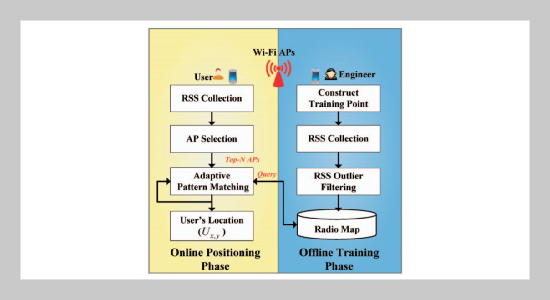REFERENCES
- [1] Zhu, L., Yang, A., Wu, D. and Liu, L., “Survey of Indoor Positioning Technologies and Systems,” Life System Modeling and Simulation, Vol. 461, pp. 400 409 (2014). doi: 10.1007/978-3-662-45283-7_41
- [2] Prithiviraj, V., Krishnaveni, B. V. and Jayabharathy, R., “Evaluating Context Based Indoor Positioning System Using Wi-Fi Standards,” Proc. of International Conference on Communications and Signal Processing, India, Apr. 35, pp. 982987 (2013). doi: 10. 1109/iccsp.2013.6577203
- [3] Pritt, N., “Indoor Location with Wi-Fi Fingerprinting,” Proc. of IEEE Applied Imagery Pattern Recognition Workshop: Sensing for Control and Augmentation, Washington, Oct. 2325, pp. 18 (2013). doi: 10. 1109/AIPR.2013.6749334
- [4] Hossain, A. K. M. M. and Soh, W. S., “A Survey of Calibration-free Indoor Positioning Systems,” Computer Communications, Vol. 66, pp. 113 (2015). doi: 10.1016/j.comcom.2015. 03.001
- [5] Gu, Y., Lo, A. and Niemegeers, I., “A Survey of Indoor Positioning Systems for Wireless Personal Networks,” IEEE Communications Surveys & Tutorials, Vol. 11, No. 1, pp. 1332 (2009). doi: 10.1109/SURV.2009.09 0103
- [6] Boonsriwai, S. and Apavatjrut, A., “Indoor Wi-Fi Localization on Mobile Devices,” Proc. of International Conference on Electrical Engineering/Electronics, Computer, Telecommunications and Information Technology (ECTI-CON), Gwangju, May. 1517, pp. 15 (2013). doi: 10.1109/ECTICon.2013.6559592
- [7] Kim, J., Ji, M., Cho, Y., Lee, Y. and Park, S., “Fingerprint DB Generating System Exploiting PDR Based Dynamic Collection for Indoor Localization of Smartphone Users,” Proc. of 13th International Conference on Control, Automation and Systems (ICCAS), Oct. 2023, pp. 715718 (2013). doi: 10.1109/ICCAS.2013. 6703964
- [8] Ankur, A., Parakram, K. and Huzur, S, “LOCATOR: Location Estimation System for Wireless LANs,” Proc. of Wireless Mobile Applications and Services on WLAN Hotspots, U. S. A., Sep. 26Oct. 1, pp. 102 109 (2004).
- [9] Lin, T. N., Fang, S. H., Tseng, W. H., Lee, C. W. and Hsieh, J. W., “A Group-discrimination-based Access Point Selection for WLAN Fingerprinting Localization,” IEEE Transactions on Vehicular Technology, Vol. 63, No. 8, pp. 39673976 (2014). doi: 10.1109/ TVT.2014.2303141
- [10] Lee, C. W., Lin, T. N., Fang, S. H. and Chou, Y. C., “A Novel Clustering-based Approach of Indoor Location Fingerprinting,” Proc. of IEEE 24th International Symposium on Personal Indoor and Mobile Radio Communications (PIMRC), London, Sep. 811, pp. 3191 3196 (2013). doi: 10.1109/PIMRC.2013.6666696
- [11] Fang, S. H. and Lin, T. N., “Accurate WLAN Indoor Localization Based on RSS Fluctuations Modeling,” Proc. of IEEE International Symposium on Intelligent Signal Processing, Budapest, Aug. 2628, pp. 2730 (2009). doi: 10.1109/WISP.2009.5286581
- [12] Zhou, Y., Chen, X. and Zeng, S., “AP Selection Algorithm in WLAN Indoor Localization,” Information Technology Journal, Vol. 12, No. 16, pp. 37733776 (2013). doi: 10.3923/itj.2013.3773.3776
- [13] Miao, H., Wang, Z., Wang, J., Zhang, L. and Liu, Z., “A Novel Access Point Selection Strategy for Indoor Location with Wi-Fi,” Proc. of the 26th Chinese Control and Decision Conference (2014 CCDC), Changsha, China, May. 31Jun. 2, pp. 52605265 (2014). doi: 10.1109/CC DC.2014.6853119
- [14] Nuaimi, K. A. and Kamel, H., “A Survey of Indoor Positioning Systems and Algorithms,” Proc. of International Conference on Innovations in Information Technology (IIT), Abu Dhabi, Apr. 2527, pp. 185190 (2011). doi: 10.1109/INNOVATIONS.2011.5893813
- [15] Atia, M. M., Noureldin, A. and Korenberg, M. J., “Dynamic Online-calibrated Radio Maps for Indoor Positioning in Wireless Local Area Networks,” IEEE Transactions on Mobile Computing, Vol. 12, No. 9, pp. 17741787 (2013). doi: 10.1109/TMC.2012.143
- [16] Bahl, P. and Padmanabhan, V. N., “RADAR: an In-building RF-based User Location and Tracking System,” Proc. of IEEE INFOCOM 2000, Tel Aviv, Mar. 2630, pp. 775784 (2000). doi: 10.1109/INF COM.2000.832 252
- [17] Bahl, P., Padmanabhan, V. N. and Balachandran, A., “Enhancements to the RADAR User Location and Tracking System,” Microsoft Research, Report No. MSR-TR-2000-12, Redmond, WA, U.S.A. (2000).
- [18] Gansemer, S., Grossmann, U. and Hakobyan, S., “RSSI-based Euclidean Distance Algorithm for Indoor Positioning Adapted for the Use in Dynamically Changing WLAN Environments and Multi-level Buildings,” Proc. of International Conference on Indoor Positioning and Indoor Navigation (IPIN), Zurich, Sep. 1517, pp. 16 (2010). doi: 10.1109/IPIN.2010.5648 247
- [19] Youssef, M. A., Agrawala, A. and Shankar, A. U., “WLAN Location Determination via Clustering and Probability Distributions,” Proc. of International Conference on Pervasive Computing and Communications, Fort Worth, Mar. 26, pp. 143150 (2003). doi: 10. 1109/PER COM.2003.1192736
- [20] Ma, L., Ma, X., Liu, X. and Xu, Y., “WLAN Indoor Positioning Algorithm Based on Sub-regions Information Gain Theory,” Proc. of IEEE Wireless Communications and Networking Conference (WCNC), Shanghai, China, Apr. 710, pp. 47894794 (2013). doi: 10.1109/ WCNC.2013.6555351
- [21] Bergamasco, M., Rossa, F. D. and Piroddi, L., “Active Noise Control of Impulsive Noise with Selective Outlier Elimination,” Proc. of American Control Conference (ACC), Washington, Jun. 1719, pp. 41654170 (2013). doi: 10.1109/ACC.2013.6580479
- [22] Li, B., Salter, J., Dempster, A. G. and Rizos, C., “Indoor Positioning Techniques Based on Wireless LAN,” Proc. of IEEE International Conference on Wireless Broadband and Ultra Wideband Communications, Australia, Mar. 1316, Paper 113 (2006).
















